First known time: A para-FKT on the White Rim Trail
This article originally appeared on Velo News
On October 5, a group of six mountain bikers will attempt to set a new FKT on the 100-mile White Rim Trail, a rugged four-wheel drive road that carves a serpentine track through Canyonlands National Park.
They are not your typical group of mountain bikers, and their experience will be unconventional. Some ride with prosthetics. One rides an adaptive e-mountain bike. Another yet is an osseointegration amputee, which means he has a metal implant surgically inserted into his upper leg, and a prosthetic foot attached to that.
One man rides with just one leg.

As far as FKTs go -- well, forget defending this one to the purists. The riders will have support (both in vehicles and each other), they’re riding the loop clockwise (official attempts go the other way), and some of them will be on e-bikes.
But, as the first to ever attempt a dedicated para-FKT, the riders are deciding which rules to follow. Or, better said, they’re eschewing them.
“We’re doing this to make sure we get an accurate image of para-mountain bikers in the media before the media tells us what we can and cannot do or how and what we should ride,” says Josie Fouts, the project’s director. “There are already para athletes who are pushing the limit. We want to give an accurate image of riders riding off-road.”
Who’s in?
Fouts, who comes from a traditional road and track para-cycling background, discovered mountain biking during the pandemic and realized there wasn’t really a script to follow. Although she was initially frustrated, the lack of a traditional path -- like there was with para-cycling -- became a liberation.
“I remember thinking, ‘they don’t have para-mountain biking, can I even do it?'” Fouts says.
Soon, the para-FKT idea followed, and along with it a film project. She found other people with limb differences who were riding mountain bikes and asked if they’d come along. She solicited support from the bike industry and non-profits who work with disabled athletes.
Ultimately, Fouts assembled a crew of five to join her in the attempt: Leo Rogers, Roger Withers, Annijke Wade, Steven Wilke, and Matt Meredith.
Meredith, a mountain athlete from Utah, will be riding the White Rim Trail for the second time.
The team is unified in its goal to complete the White Rim Trail together and to inspire anyone else who might want to try it. And, their stories will help flesh out the conversation about access and accessibility and the advances and antiquities of prosthetic technology, to name a few other pertinent topics.
The project is being largely supported by the National Ability Center, a Utah-based non-profit organization that “provides world-class adaptive recreation and outdoor adventures for individuals and families with disabilities, physical, cognitive, and developmental, including competitive athletes, youth, veterans, and more.” An Australian physician, Dr Munjed Al Muderis, who pioneered the process of osseointegration, a process that uses a titanium rod anchored directly to the bone, is also a supporter.
Withers, one of the riders, had the procedure two years ago, and calls it “life changing.”
While the para-FKT project is an immense opportunity to shed light on issues specific to the adaptive community, (like “the lack of innovation in prosthetics,” Fouts says), it’s also a story about riding bikes. Yet, Fouts hasn’t received any significant financial support from the cycling industry.
She says that the lack of interest stems from the fact that para-mountain biking is such a tiny sector of the market. However, she’s not letting it bum her out.
“What I can do is create an opportunity instead of calling out the industry. Instead of feeling called out, you can call in.”
Fouts isn’t waiting around for the bike industry to join her, but she’ll welcome it when it does. It’s a similar attitude to the one she has about the para-FKT itself: if she and her friends don’t set one, who will?
First is fastest
Various people have assigned various rules to the concept of the ‘fastest known time,’ but, as Fouts says, “when you add para, it changes the conversation.” On Wednesday, the riders will be doing the para-FKT their own way.
“We're gonna have emotional and physical support, and that's based on our needs as para athletes,” says Annijke Wade, one of the athletes. “Part of the idea too is to break down stigmas ... does this is really give us an advantage? No we're already fucking disadvantaged!”
Wade, who rides a Bowhead Reach adaptive e-MTB, only just started riding last November after a mountain biking accident paralyzed her below the waist in July.
She’s under no illusion that this ride will be ‘fast.’ What it will do, however, is provide some benchmarks for all types of para-mountain bikers who might want to ride for a time.
“The idea eventually, as we complete it, is an FKT for each of those different types of equipment,” she says. “A lot of para sports have classifications, top-down from an organization. There is no off-road para or mountain bike org that's running the game. Different groups are trying to set standards for equipment, but we don't have standards. In a lot of ways, we can create it.”

For Fouts, who dabbled in para-cycling for three years, prepping the blank canvas of para-mountain biking is one aim of the para-FKT project.
However, she also realizes the nuance -- while standards and rules can be helpful, they can also be discouraging. That’s why she ultimately decided to bring a group along for the para-FKT, instead of doing it solo.
“I've realized there's a huge assumption that we're gonna split up out there, why would we do that?” she says.
Withers, the osseointegration amputee who has traveled all the way from Australia for the para-FKT, is a longtime mountain biker and sees the utility in both sides of the story.
“I wouldn’t mind coming back for a timed run,” he says. “But this isn't about that. It's the challenge, doing it together, and enjoying the experience. For me, if I have to crawl to the end, I'll crawl, and I won't give up.”
A para-fastest known time, or a para-first known time -- Fouts isn’t that concerned with semantics. Ultimately, the ride is about getting more people, especially those with limb differences, on bikes.
“You could have a temporary or long term impairment,” Fouts says. “You could be anyone of any type of ability who wants to be better. That opens the door for anyone. When we pave the way for people who need accessibility the most, we pave the way for everyone.”
Ed. note -- After this story was published, we learned that Outride, a non-profit that partners with schools and cycling education programs, recently came on as a co-supporter of the White Rim Trail para-FKT project
For exclusive access to all of our fitness, gear, adventure, and travel stories, plus discounts on trips, events, and gear, sign up for Outside+ today.

